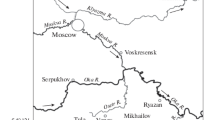Abstract
The easternmost known record of the slow loris,Nycticebus coucang, is Tawitawi, Philippines. A report of this species in Mindanao, 500 km northeast of Tawitawi, is based on a mislabeled specimen.
Similar content being viewed by others
References
Boddaert, P. (1784).Elenchus Animalium, Vol. 1: Systens Quadrupedia, C. R. Hake, Rotterdam.
Bourns, F. S., and Worcester, D. C. (1894). Preliminary notes on the birds and mammals collected by the Menage Scientific Expedition to the Philippine Islands.Occ. Pap. Minn. Acad. Nat. Sci. 1: 1–64.
Cabrera, A. (1908). Sobre los loris, y en especial sobre la forma filipina.Boln R. Soc. esp. Hist. Nat. 8: 135–139.
Davis, D. D. (1962). Mammals of the lowland rain-forest of North Borneo.Bull. Singapore Natl. Mus. No. 31: 1–129.
Elera, Castro de (1915).Contribucion a la Fauna Filipina, Colegio de Sto. Tomás, Manila.
Groves, C. P. (1971). Systematics of the genusNycticebus. In Biegert, J., and Leutenegger, W. (eds.),Proceedings of the Third International Congress of Primatology, Zurich 1970, Volume 1, S. Karger, Basel, pp. 44–53.
Hollister, N. (1912). A list of the mammals of the Philippine Islands, exclusive of the Cetacea.Philipp. J. Sci. Ser. D 7: 1–64.
Hollister, N. (1913). A review of the Philippine land mammals in the United States National Museum.Proc. U.S. Natl. Mus. 46: 299–341.
Jenkins, P. D. (1987).Catalogue of Primates in the British Museum (Natural History) and Elsewhere in the British Isles, Part IV: Suborder Strepsirrhini, Including the Subfossil Madagascan Lemurs and Family Tarsiidae, British Museum (Natural History), London.
Lydekker, R. (1893). Mammalia.Zool. Rec. 29: 1–55.
Musser, G. G., and Heaney, L. R. (1985). PhilippineRattus: A new species from the Sulu Archipelago.Am. Mus. Novit. No. 2818: 1–32.
raffles, T. S. [1821]. Descriptive catalogue of a zoological collection, made on account of the Honourable East India Company, in Sumatra and its vicinity.Trans. Linn. Soc. Lond. 13: 239–274.
Rand, A. L., and Rabor, D. S. (1960). Birds of the Philippine Islands: Siquijor, Mount Malindang, Bohol, and Samar.Fieldiana Zool. 35: 223–441.
Sánchez y Sánchez, D. (1900). Los mamiferos de Filipinas (Continuación).An. Soc. esp. Hist. Nat. 29: 177–290.
Taylor, E. H. (1934).Philippine Land Mammals, Bureau of Science, Manila.
Timm, R. M., and Birney, E. C. (1980). Mammals collected by the Menage Scientific Expedition to the Philippine Islands and Borneo, 1890–1893.J. Mammal. 61: 566–571.
Timm, R. M., and Birney, E. C. (1991). Systematic notes on the Philippine slow loris,Nycticebus coucang menagensis (Lydekker) (Primates: Lorisidae) (in preparation).
Author information
Authors and Affiliations
Rights and permissions
About this article
Cite this article
Fooden, J. Eastern limit of distribution of the slow loris,Nycticebus coucang . International Journal of Primatology 12, 287–290 (1991). https://doi.org/10.1007/BF02547589
Received:
Issue Date:
DOI: https://doi.org/10.1007/BF02547589




